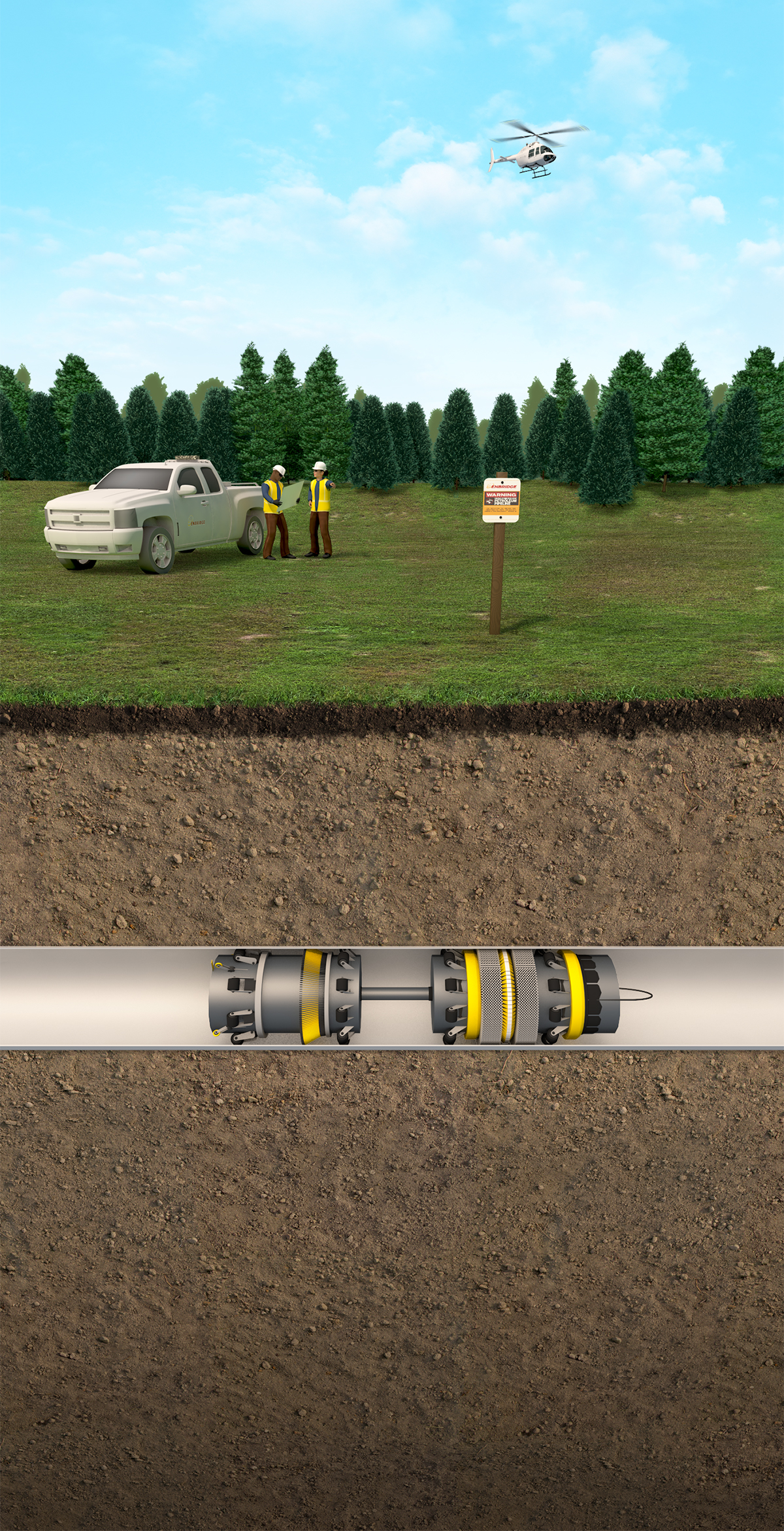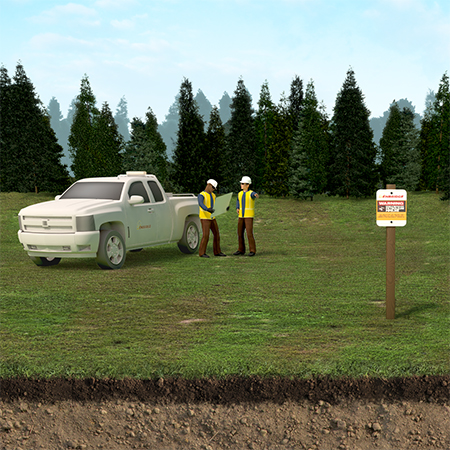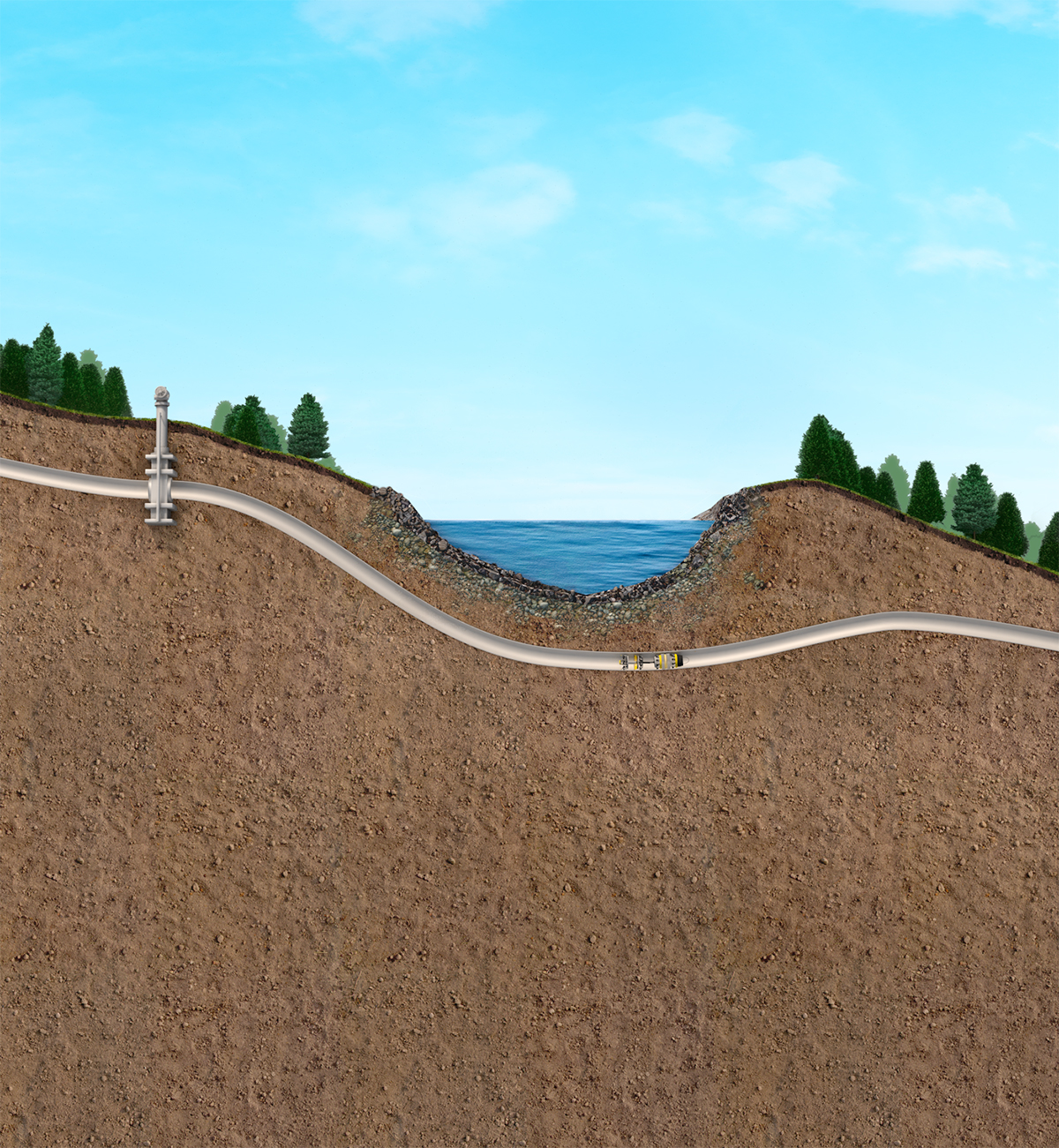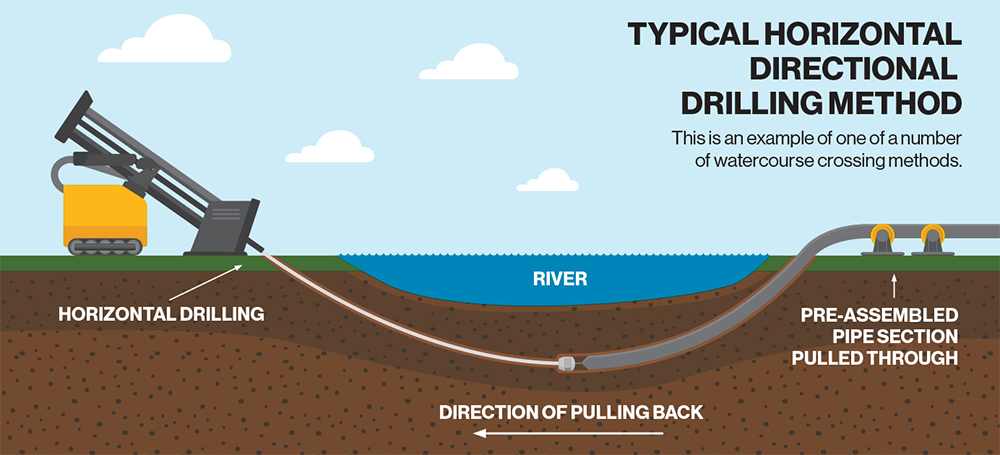

Operations
Safety is the very foundation of our business. At Enbridge, we believe that all pipeline incidents can be prevented.
We back up that belief with an aggressive prevention program to maintain the fitness of our systems. We also back up that belief with vigilance, hard work and an abundance of caution.
Explore our commitment to pipeline safety, on land and water, through this interactive experience.
PLEASE NOTE: The objects and terrain presented in this experience may not be to scale.


While our new enbridge.com website is almost universally mobile-friendly, this particular interactive experience is best experienced in a desktop or laptop environment. Enjoy!
Safety: The very foundation of our business.
When it comes to fueling the quality of people’s lives, safety and reliability are built in to our energy infrastructure.
We invest heavily in an aggressive prevention program, which invested US$1.27 billion (C$1.74 billion) in 2024 on programs that help us maintain the fitness of our systems and detect leaks across our operations.
Safe Systems 24/7/365
An overview of our approach to pipeline safety.
Regular aerial patrols
We regularly fly the more than 37,000 miles (59,500 km) of our liquids and gas pipelines—watching out for potential issues, including excavation or third-party activity near our pipelines that might pose a risk to safety.
Meticulous selection of pipeline routes
We propose routes that minimize impact on the land, the environment and wildlife in order to safely move the energy that fuels quality of life.
Over the years, we have learned that the best projects are often those that involve constructive input from stakeholders. For this reason, we plan all routes in consultation with landowners, First Nations, Metis and Native Americans, neighboring communities, environmental groups and regulators.
Regular ground patrols
We regularly patrol pipeline rights-of-way, continuously monitor our emergency hotlines, and respond to any potential problems along our rights-of-way.
Preventing third-party damage
We want our neighbors and communities to be safe. We communicate regularly with them about our systems, projects and operations so they know what to expect and how to stay safe around our facilities, pipelines and distribution systems. Their awareness also helps reduce third-party damage, one of the leading causes of pipeline leaks.
Call/Click Before You Dig programs
Electricity, water, cable, wifi, and oil and gas transportation and distribution are among the important services underground utilities provide to each of us. To protect public safety and the systems that deliver these key services, one-call and online programs exist across North America for anyone planning to dig. Whether it’s construction, excavation, landscaping, or outdoor home renovations, including building fencing, decks or swimming pools, know what’s below. Call 811 in the U.S., or visit clickbeforeyoudig.com in Canada, if you’re planning to dig.
Pipeline monitoring
We monitor our entire pipeline network around the clock, 365 days a year, from our dedicated pipeline control center.
Specially trained staff, working with sophisticated computer monitoring systems,
keep a close watch over the operation of our pipeline network to keep it running safely and reliably.
Start of dialog
Learn more
Round-the-clock vigilance through 24/7 pipeline monitoring
At Enbridge, we monitor our pipelines around the clock, 365 days a year, using trained operators and multiple computer monitoring systems. Because for us, safety isn’t just a job. It’s a 24/7 commitment. Watch the video.
Trained staff, multiple computerized systems
Every day, we monitor our entire pipeline network around the clock through dedicated control centers. Using sophisticated cameras and computer-monitoring systems, specially trained staff—known as controllers—work in our Pipeline Control Center and watch over operation of our crude oil and liquids pipeline network to keep it running safely and reliably. The controllers receive a comprehensive, minimum six-month training before they are qualified and allowed to operate consoles independently.
We monitor our pipelines for possible leaks using multiple computerized systems, each with a different focus and each using different technology, resources, and timing, including automated leak detection alarms. Together, these methods provide overlapping and layered leak detection capabilities. Exercising an abundance of caution, we treat all notifications as leaks until we conclusively prove otherwise. Learn more about leak detection and prevention systems for our crude oil network here.
Keeping a watchful eye
Our gas transmission pipeline network is also monitored 24/7. Trained staff at Enbridge’s Gas Control Center in Houston keep watch over Enbridge’s vast network of transmission pipelines as we safely and reliably transport natural gas from various supply sources to key delivery markets across the United States.
It’s their job to keep the pipelines operating safely, monitor all our facilities and prevent incidents from occurring. Learn more.
End of dialog
The gold standard in pipelines
The safety of our pipelines starts with the best steel and the best-made pipe—the gold standard when it comes to pipelines.
Our pipe steel itself is made of 96% recycled metal. This alloy is not only a greener product, but also represents excellent chemistry for line pipe.
Weld quality in the pipe mill is examined by the manufacturer using automated ultrasonic devices, and Enbridge inspectors audit those results.
The eyes and ears of our pipeline safety program
Inline inspection (ILI) tools move through our pipeline network and use advanced sensor technology to inspect pipe walls millimeter by millimeter.
They identify and report even the most minuscule changes that may require follow-up maintenance.
Watch the video.Harnessing decades of welding innovation.
Our pipeline projects now benefit from more than 50 years of welding engineering and pipe design innovation.
In the pipe mill, Enbridge’s supplier uses a Double Submerged Arc Welding (DSAW) process to create strong seam weld joints on either helical seams or straight seams.
In the field, crews working on major projects join together segments of pipe with girth welds, using the Gas Metal Arc Welding (GMAW) process. Qualified welders operate automated welding units—one that performs an initial weld from the interior, another that completes the work from the exterior.
Out on the pipeline right-of-way, an independent third party tests all welds, primarily using ultrasonic technology, with Enbridge auditors reviewing all of the scans as a second pair of eyes on the initial evaluations.
Learn more about the welding component of Enbridge's major projects.
Healthy pipelines
Maintaining the fitness of our pipes is key to ensuring a safe network. We’ve never experienced an internal corrosion failure on our mainline network, and we employ multiple measures to ensure pipeline fitness, including:
- Robust pipeline coatings, consisting of fusion-bonded epoxy, to curb corrosion
- Regular monitoring and inspections
- Cathodic protection—applying a low electrical current to the steel in the pipeline—to protect against corrosion
- Enforcing stringent quality standards—for viscosity, density, temperature and other factors—for every batch of oil entering our pipeline network
- Injecting chemicals into the oil in our lines to neutralize corrosion
- Regular inline cleaning with specialized tools
Focused on prevention
We are focused on preventing incidents before they occur, and ongoing pipeline inspections play a key role in our prevention strategy.
We complete hundreds of in-line inspections annually on our pipeline and distribution systems. These inspections allow us to monitor the physical condition of the pipelines from the inside out, using sophisticated tools to gather the information we need to keep our systems healthy and in excellent condition.
Preventative pipeline maintenance
Enbridge's ongoing preventative maintenance program includes regular examinations of our pipes, using our in-line inspection tools, and preventative maintenance digs—some of which may happen in your area. Our focus on prevention is just one aspect of our multi-pronged approach to safety.
Watch our preventative pipeline maintenance video
See our maintenance dig fact sheet for crude and liquids pipelines.
See our maintenance dig fact sheet for gas transmission pipelines.
Hydrostatic testing
We hydrostatically test all new pipelines prior to putting them into service.
Each pipe section is filled with water and subjected to 1.25 to 1.5 times the maximum allowable operating pressure to ensure the strength and structural integrity of the pipe, welded joints, valves and fittings.
As with all our activities, we conduct hydrostatic testing with a focus on protecting the safety of our neighbors and the public, our employees and the environment.
Learn more about our hydrostatic testing procedure.
‘A truly revolutionary technology’
Enbridge and NDT Global, a worldwide pipeline inspection leader, have developed a next-generation crack inspection tool that takes pipeline safety to the next level. This inline inspection tool’s advanced Proton measurement technologies allow for better pipeline fitness assessment—by identifying and sizing features that were never previously detectable. “This really is cutting-edge technology,” says NDT Global CEO Richard Matthews, “(that will) drive the direction of mainstream inspection robots of the future.”
LEARN MOREEmergency response readiness
While our primary focus is on preventing incidents from occurring, it's also important to be prepared. We hope we never have to respond to a pipeline leak—but if we do, we're ready.
LEARN MOREA ‘current’ affair: Preserving our pipes with cathodic protection
Prevention is a critical component of pipeline safety. At Enbridge, we focus heavily on prevention measures to keep our pipeline network healthy, as well as fit for service, and identify potential issues before they arise.
One of those important prevention measures is cathodic protection—the application of a DC current—to curb external corrosion on our oil and natural gas pipes.
LEARN MORE
WATERCOURSE CROSSINGS
Water is a treasured resource for all of us. Enbridge takes special precautions
to protect the environment where our pipelines cross waterways or other sensitive areas.
Intelligent, remotely controlled valves
Isolation valves, which control or stop the flow of crude oil, are a key piece of pipeline safety equipment. We monitor our pipeline system 24/7/365, and we can remotely close a valve immediately on detection of a potential problem—with full closure within three minutes of activation.
Intelligent Valve Placement
See how we use isolation valves in a variety of situations to control the flow of crude oil and liquids in our pipelines.
'You lose that water access ... that is devastation'
Find out how we worked with Saskatchewan irrigation farmers during our Line 3 pipeline replacement to ensure they had a vital supply of water for their crops.
Responding quickly and effectively—in any season
While Enbridge focuses primarily on prevention methods to keep our pipeline network healthy, as displayed elsewhere on this page, we also invest heavily in the tools, technologies and systems that ensure a safe, quick and effective response in the event of a spill.
And why do we stay sharp, even in winter? Because pipeline emergency preparedness doesn’t take winter breaks. We regularly hold emergency response drills in the winter months, as we do during the rest of the year, but these focus specifically on winter spill containment and recovery tactics.
Read about our purchase and deployment of a Lamor Arctic Skimmer tool in Michigan.
Read about one of our winter drills in Devils Lake, North Dakota.
Underwater inspections
As with surface examinations, our high-tech in-line inspection tools examine the pipe inch by inch, from the inside out.
In special cases, like our Line 5 Straits of Mackinac underwater crossing in northern Michigan, we also use specially trained scuba divers and remotely operated submersibles to thoroughly examine the pipe’s exterior and its immediate environment.
Horizontal Directional Drilling
We use horizontal directional drilling to minimize disturbance and increase the safety of our systems when we lay pipelines beneath large rivers or sensitive crossings.

You’ve seen how we build safety into our operations. Now, find out how Enbridge commits to putting safety first and being transparent—when it comes to our operations as a company, and our actions as a neighbor.










